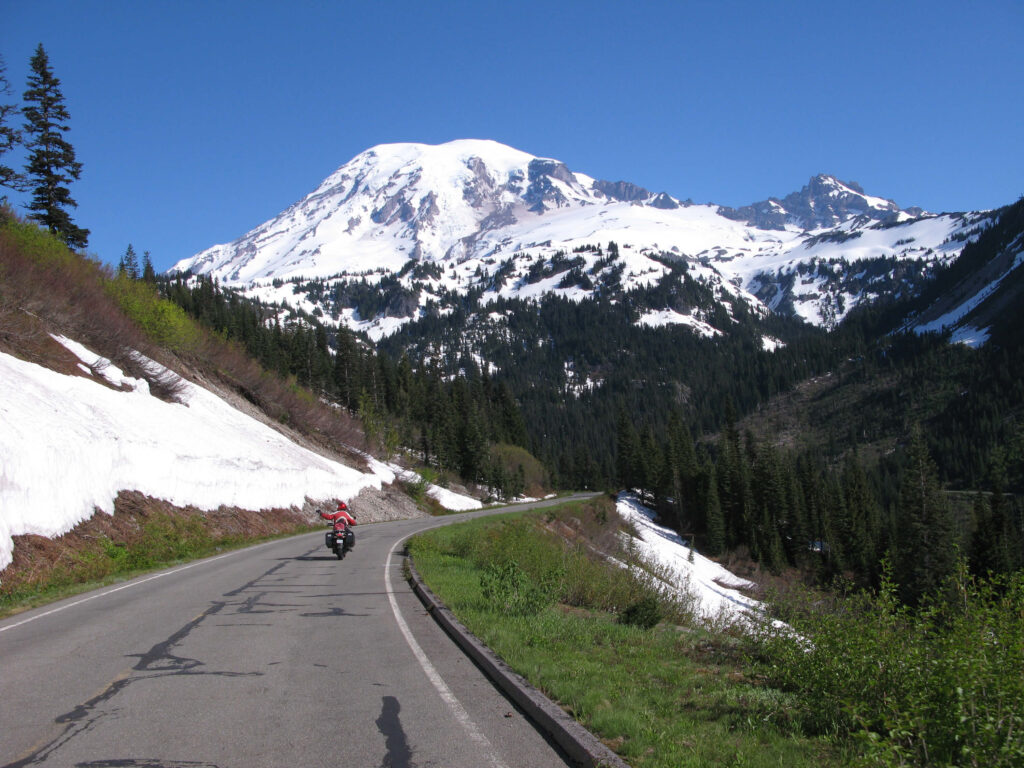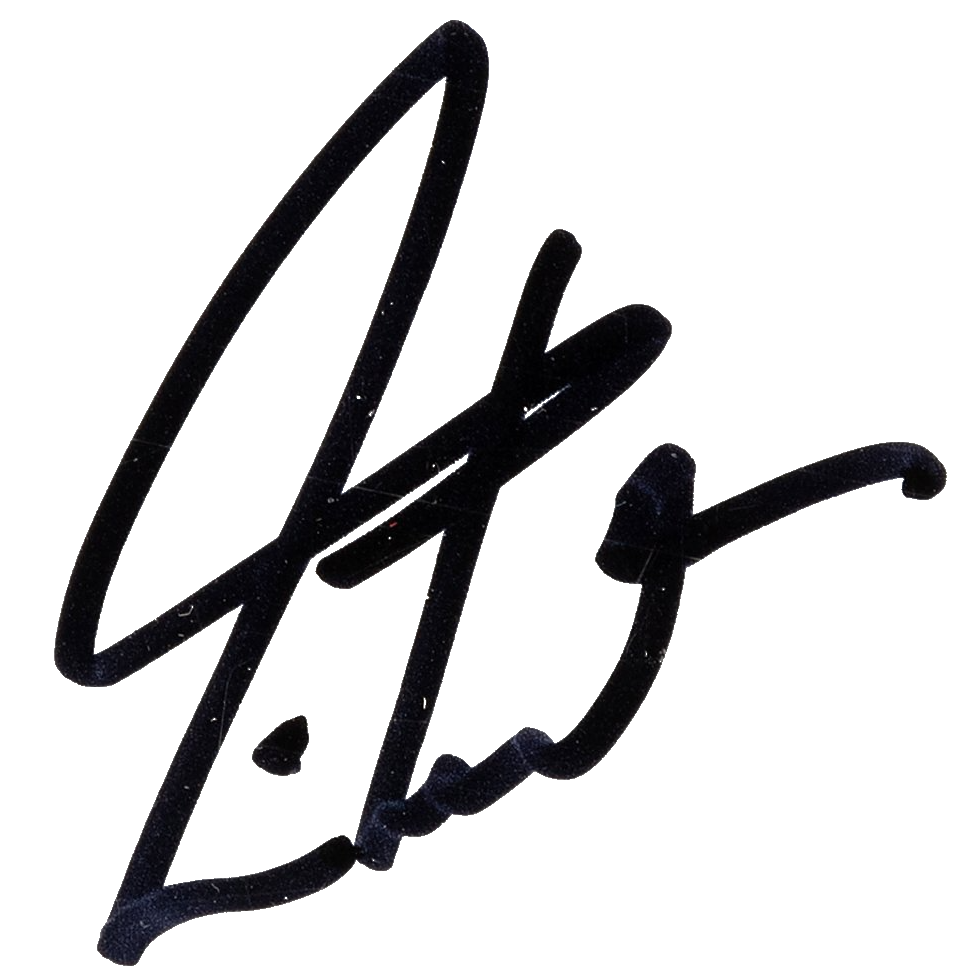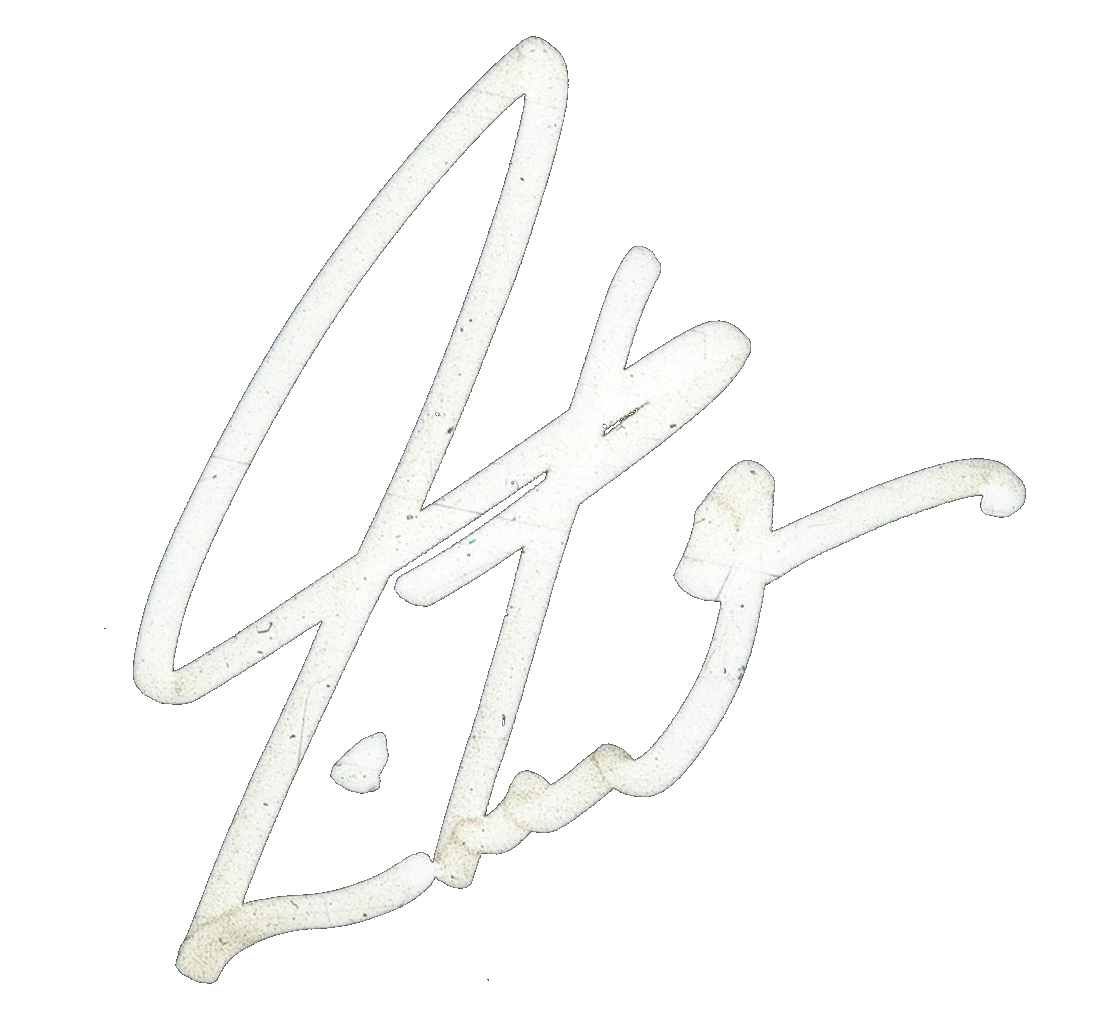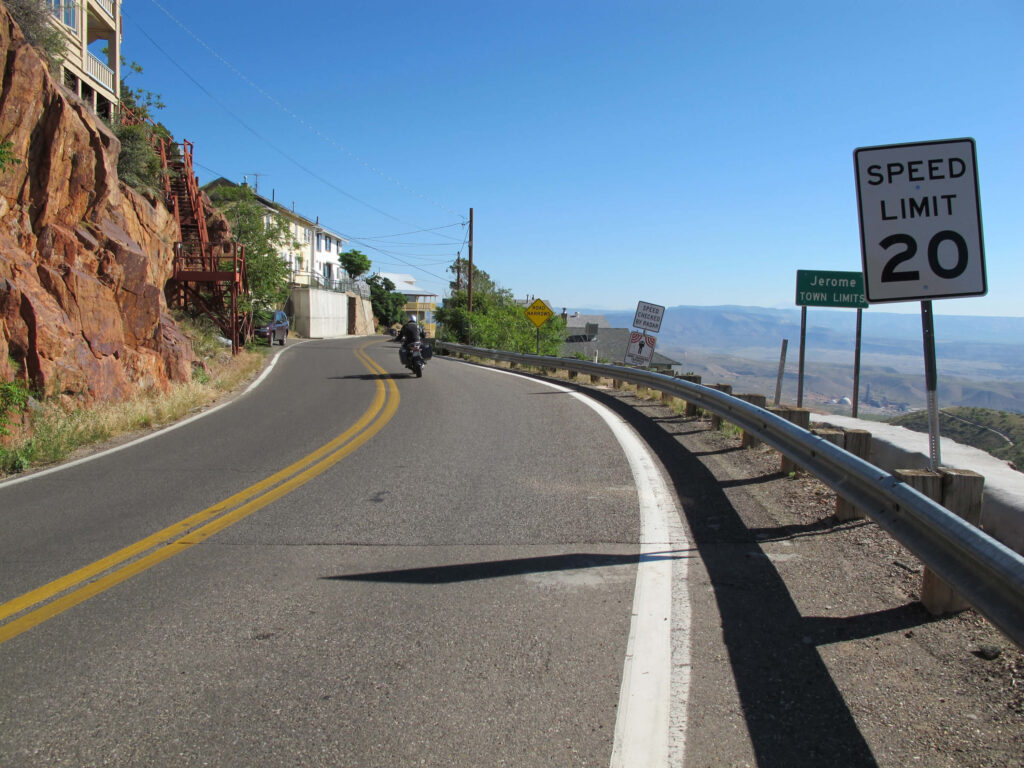
The following day led us down through the quirky little town of Jerome, Arizona, perched on the edge of a cliff. Nowadays it is a “ghost town for tourists,” with only a few hundred inhabitants, but it is also somewhat of an artists’ retreat. And like many little places I encounter, Jerome has a rich and colorful history. Little-known places like Jerome (though among “famous residents,” they list Maynard James Keenan from the band Tool) always tempt me to dash off on another tangent about their amazing histories—but I try to leave interested readers with a hint of where the stories lay, and let them explore on their own if they wish. (Sounds like a good recipe for education!)
Three fun facts about Jerome:
1) In 1903, a New York newspaper dubbed Jerome “the wickedest town in the West.”
2) The town was named after a New York financier who never visited the place, just invested in the mines—which brought in billions in copper, gold, and silver ore for seventy years.
3) In the early twentieth century, the miners were infiltrated by union organizers from the IWW (International Workers of the World, or the “Wobblies”). The “communist agitators” were rounded up, roughed up, shoved into railroad cattlecars, and dumped in Kingman—under threat of death if they returned. It became known in labor history as the “Jerome Deportation.”
From Jerome, Michael and I struck off along a remote National Forest road in the pinewoods (well west of the fires), and got our daily dose of off-pavement exploring.
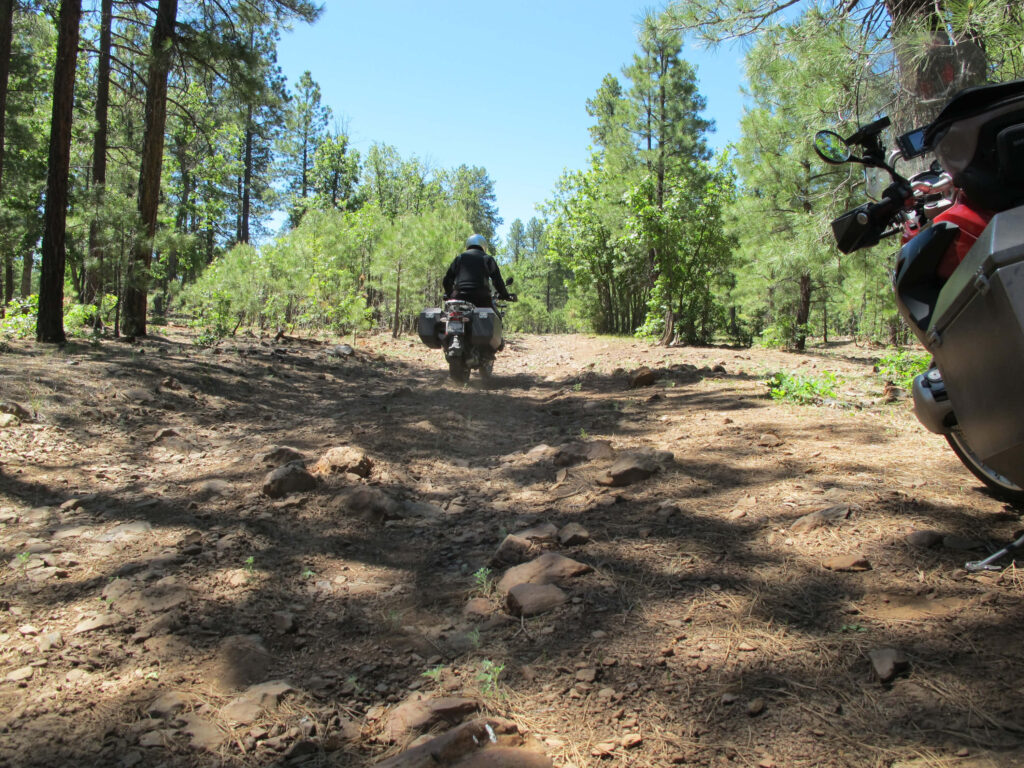
Lately Michael and I have adopted the method Brutus and I used in Europe to get our riding photographs. Because both of us had cameras, one would ride by while the other photographed, then keep riding on while watching for another good background, where he would stop to shoot a few of the following rider. “Leapfrog photography,” we called it. It also happened that the camera Brutus had—a Panasonic Lumix with a Leica lens—took particularly good pictures in dim light. That had been well proven in England, and after I bought the same camera for Michael, we would notice the same effect in the similarly gloomy light of the Pacific Northwest. With both of us taking photographs, we could collect plenty of them without taking too much time from the day’s journey.
That day we got a double dose of off-pavement riding, as we worked our way southeast to the Apache Trail. We had ridden that road a few years before with this site’s Master of All Things Creative, Greg Russell, and it might stand as a paragon for our kind of motorcycling. A little over twenty miles of gravel, decently graded and not too soft, followed by the same distance of twisty pavement, low speed and highly technical, following the Salt River down toward Phoenix.
It was almost enough to let you forget that it was 107 degrees all around you.
But you couldn’t ignore that harsh reality.
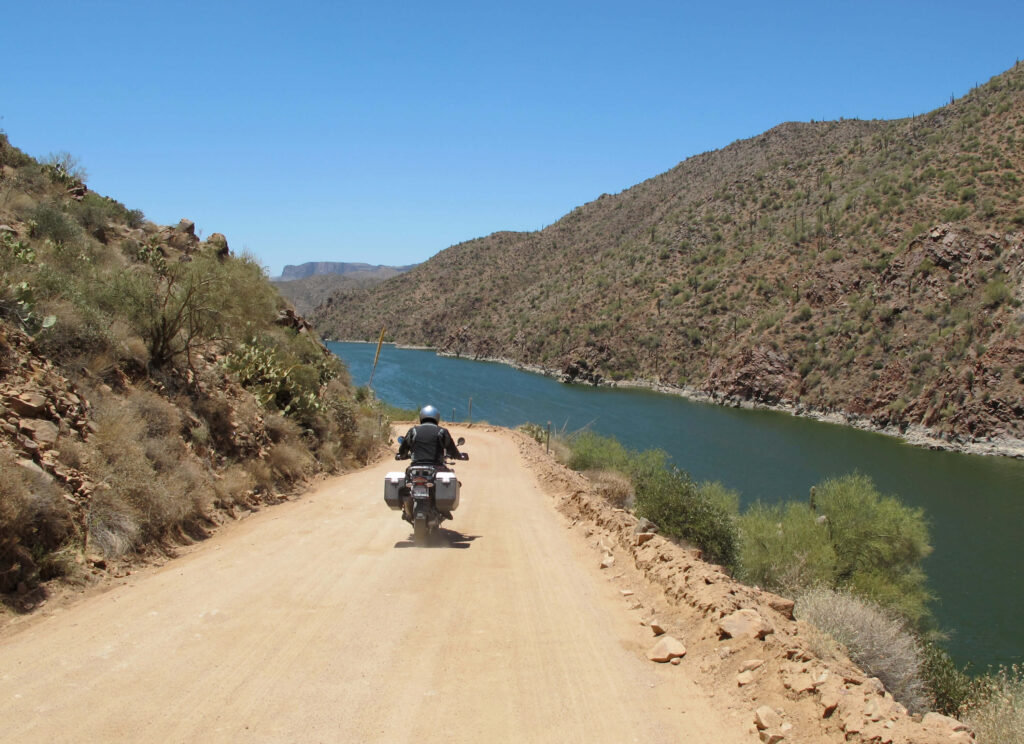
During a series of shows in Southern California, I was able to “commute” from home, which was nice. Though I was only “half-home”—still mentally in mid-tour, in mid-flight. But half was better than none.
On the day of the next show, in Vegas on June 24, Michael and I left Los Angeles at 6:00 a.m., hoping that riding out early would help us avoid traffic—but we knew it wouldn’t beat the heat. We crossed L.A. on Interstate 10, then cut off to Twentynine Palms and “the scenic route” to Vegas, through the Mojave Desert, with its Joshua trees, creosote, and low, wrinkled brown mountains. By 9:00 a.m., when we hit Old Route 66 and Roy’s Motel at Amboy, the temperature had already topped 100 degrees.
What a relief, then, in the days of late June, to climb into the Sierra Mountains of California—the Range of Light. We rode west from Reno across the Ebbetts Pass, at 8,730 feet, surrounded by cool thin air, sweet-smelling pine forests, and lingering banks of snow at the roadside. Like many of the Sierra passes, that road was shown on the map as “Closed in Winter,” because of the great amount of snow the area received—averaging over forty feet annually.
We were comfortable in our riding clothes, breathing fresh and fragrant mountain air (often suddenly chilly from blowing across those snowbanks), and curving our way through spectacular forested scenery below snow-frosted peaks. At such times I often think of an old expression of my dad’s, “Now, this is a treat instead of a treatment!”
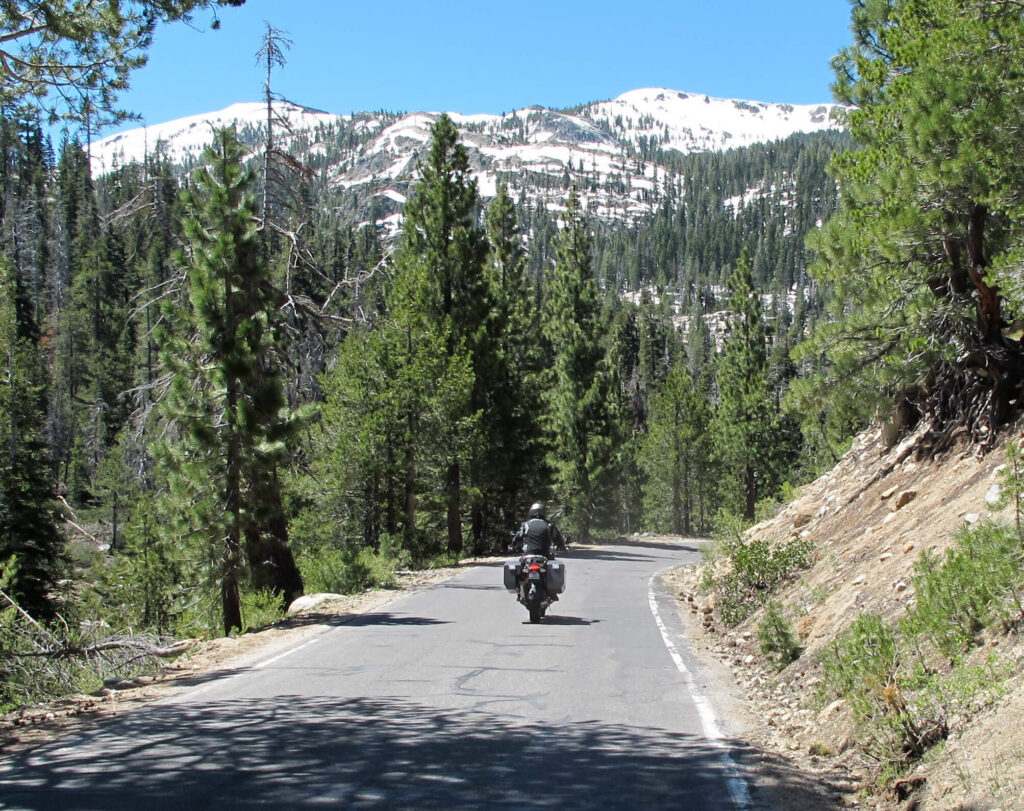
Still farther north, and still higher up, we would see a lot more snow—several times blocking our way, on National Forest tracks in Oregon and Washington state. As I have pointed out before, in the highest mountains of the West, June is still late winter. Our friend Tom Marinelli joined us in Ashland, Oregon, and we rode together up through central Oregon to Crater Lake.
Like Big Bend and Grand Canyon, the scale of Crater Lake is difficult to register when you stand before it, and even harder to carry away with you. No matter how many times I revisit majestic landscapes like that, I am freshly amazed. At over 6,000 feet of elevation, the lake itself is about five miles in diameter, and nearly two thousand feet deep—one of the deepest lakes in the world. Its water is nearly all snowmelt, and thus it is also one of the clearest lakes in the world.
Here is a glimpse of Crater Lake in passing, with Wizard Island (the original volcano’s cindercone) to the left.

Michael and I had ridden through Crater Lake National Park the previous summer, in the opposite direction, with Greg Russell. That had been in August, and we had been able to ride all the way around the lake that time. Now it was June, and much of that East Rim Road still lay under the vast snowfields that remained—from the average forty-five feet of snow the area received each winter. Another land of extremes.
(I would like to go snowshoeing there one day—to experience the sensation of walking across a landscape that is four stories below my feet.)
The highway running west of Crater Lake was open, but there was still plenty of snow around. The road was sometimes just a plowed trench between immense white cliffs.
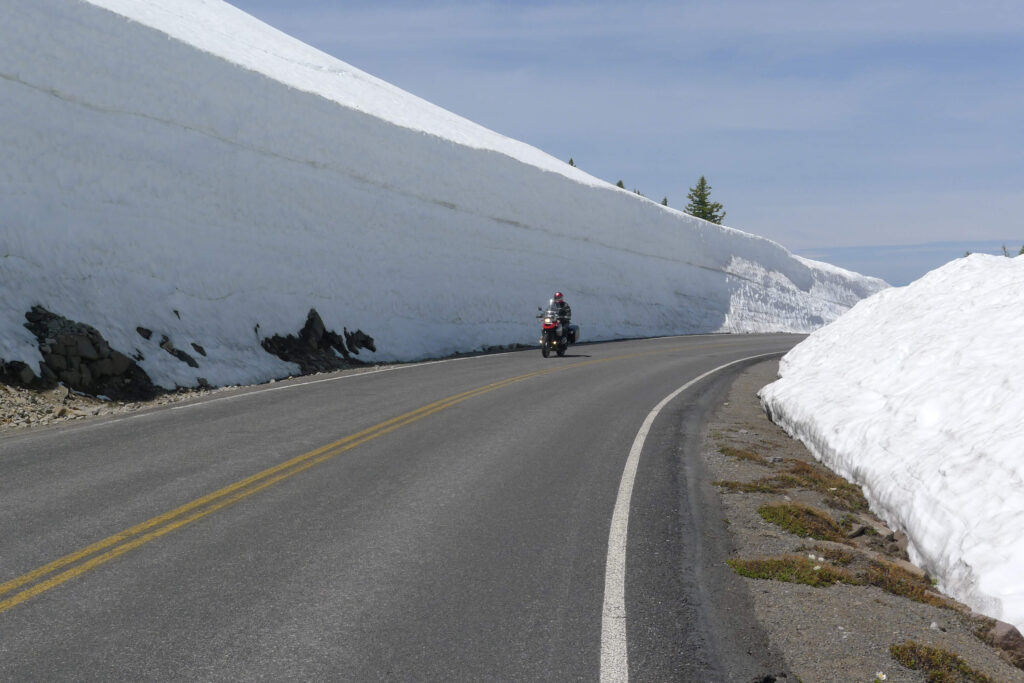
My chosen destination for that night was Bend, Oregon, which I hadn’t visited since my Ghost Rider ramblings, back in ’98 and ’99. Before that, the only thing I knew about Bend was that it was the hometown of a minor character in Jack Kerouac’s On the Road. But again, any association—any “memory bell”—is enough to make a destination for me. I had liked the area, and the town—especially the motel, with rooms right beside a swift little river, the most pleasant of night music. So I led us back to the same motel, the Riverhouse, and found it little changed (in a good way!).
Bend is also notable for being on the natural boundary between the Cascade Mountains and the desert they shadow: the Great Basin. I remembered riding east from there into the basin-and-range sagelands of Eastern Oregon and Nevada, treeless and vast, and this time I noticed that as we approached the town from the west, through the forested mountains, sage bushes began to appear under the pines—gradually fading from one vegetation zone into another.
From Bend, Tom, Michael, and I headed northwest, toward the next show near Portland, and now we were in the true Pacific Northwest—high mountains with dense forests of tall evergreens, hooded with cloud and dripping with rain.

Another American tragedy was present there, too—massive areas of ragged clear-cut, sometimes disguised by what are called “scenic corridors” (just enough trees left to frame the highway), or miles of uniform plantations—tree farms—with signs informing you when they were “harvested,” and when replanted. They were trees, all right, but it didn’t look like a forest.
In the Pacific Northwest, as in Canada’s British Columbia to the north, logging was a major industry, and thus a source of many jobs. That’s important, no question, and it is one threshold where I part company with organizations like Greenpeace. Speaking with one of their advocates once, I said I would find it hard to shut down any industry, even coal mining, when it would put so many blameless, hard-working people out of a job. The Greenpeace guy said he had no problem with bringing it all down, and he meant it, but . . . I’m a bleeding-heart libertarian.
In any case, it’s hard for me to get too judgmental about lumbering, because I like things made of wood.
Drums, for example.
Houses.
Books.
But I am glad we have those national parks, at least, to protect some of it for the future—and even for the present. Because I enjoy visiting them now, and in the West, they are often reachable on days off.
After the Portland show, we said goodbye to Tom, and Dave drove Michael and me to a truck stop in Grand Mound, Washington, just south of the state capital, Olympia. We set out in the morning to circle Olympia National Park, passing through Aberdeen, the hometown of Kurt Cobain—another American tragedy. As we waited at a red light, I pointed out a sign with the city’s slogan: “Come As You Are,” one of Cobain’s many great songs—and a clever welcome to visitors.
Michael said Nirvana songs filled his helmet for the rest of that rainy ride.
The weather was the kind that created the temperate rainforest we were passing all morning: rain. The Olympic Peninsula contained the wettest region of the continental states, averaging 135 inches annually, and the landscape around us was a blurry watercolor of dark green and gray. Glimpses into the roadside woods showed lush ferns and moss among the gnarled pillars of the treetrunks.
The downpour was constant, with occasional heavier spells, and the air was damp and chilly. We sensed rather than saw some hints of spectacular views to the left—the Pacific—but mostly just concentrated on riding safely, and getting by the slower traffic, especially the huge, double-trailer logging trucks. They threw up a cloud of spray all around that made trying to pass them treacherous. You had to hang a long way back, where you could see past the obscuring mist of their passage, and watch for a long, open stretch where you could make a safe pass.
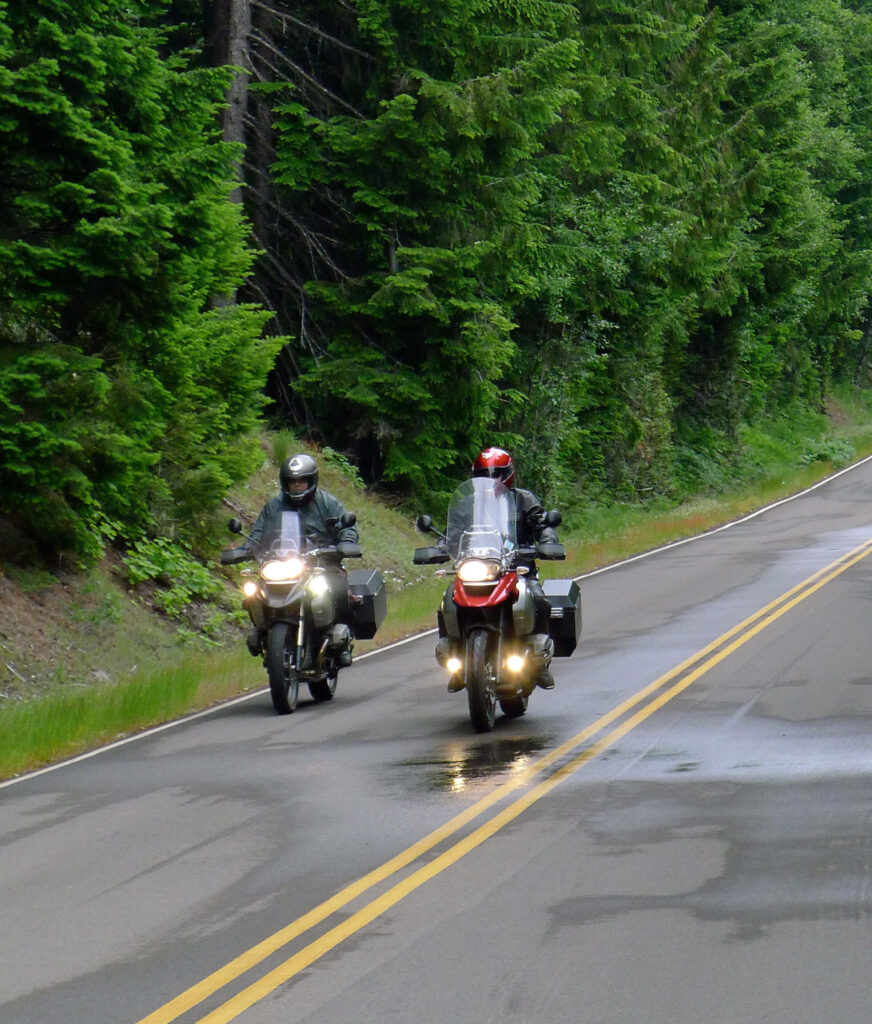
From Port Angeles, at the north end of the Olympic Peninsula, I picked up my passport stamp at the Olympic National Park Visitor Center, and we crossed to Vancouver Island by ferry. Landing at Victoria, we rode another seventy miles to a second ferry, from Nanaimo to the city of Vancouver.
There we spent a pleasant evening at the home of my brother Danny and his family, feasting on a meal prepared by the third member of our Scooter Trash gang, Brutus. At the arena the next day, the last day of June, Michael and I were also joined by another frequent riding guest, Brian Catterson, editor-in-chief of Motorcyclist magazine.
Usually we take Brian riding in the rain—it has always seemed to work out that way—but this time the weather-gods smiled upon him. And us. With Brian riding my spare bike, after the Vancouver show the three of us rode south from a town in Washington state called Sedro-Woolley (an irresistible name—though it should be noted that the town was originally called “Bug,” which hints at another place with history). We curved along the foothills of the Cascades, then higher, toward the night’s destination of Mount Rainier National Park.
It was July 1, Canada Day, but we were still in the “freezer,” surrounded by vast amounts of snow that remained from the more than seventy feet that fell in that area over a typical winter.
Under bright blue sky and brilliant sun, the scenery was unparalleled—immaculate. Approaching Mount Rainier from the north side, its 14,400-foot dome appeared above the lower forested peaks as if luminous, lit from within, like an illusion created by a special effects generator.
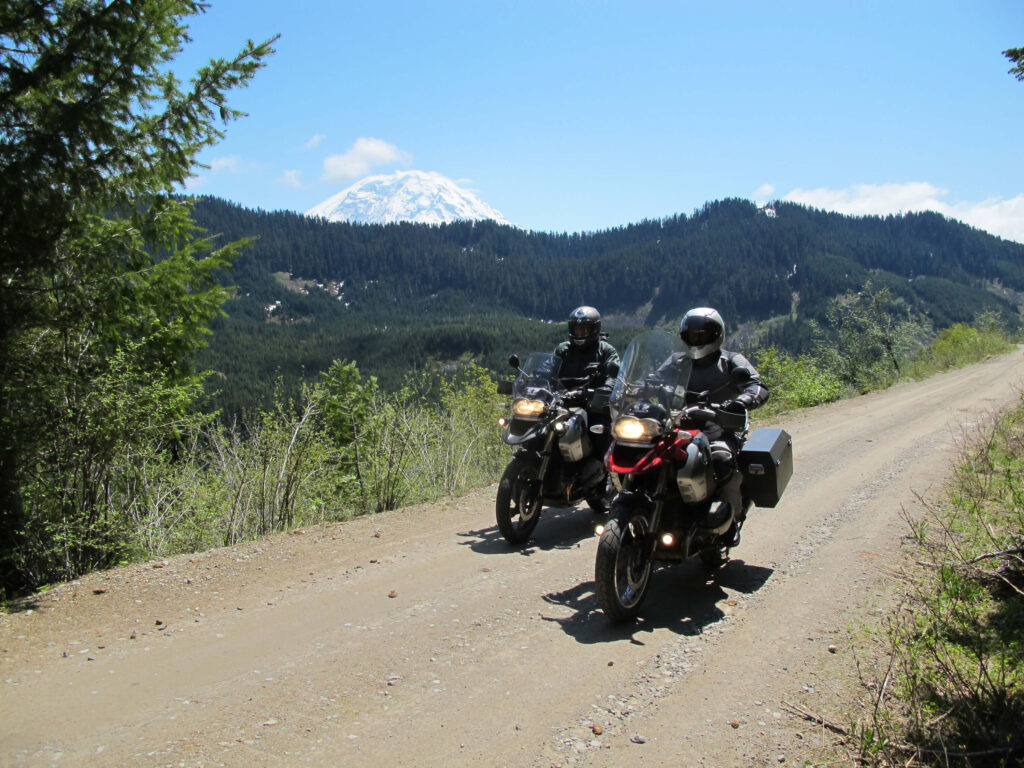
This little gravel road led through a northern section of the national park, and I had seen on the map that it was going to end—one way or another. It turned out to be lingering snowfields on a northern loop around 4,300 feet that turned us back, but no matter—I had drawn that little side trip into the route as “optional,” if we had time. The sidetrack turned out to be well worth it, beginning with lunch at the “Historical” Carbonado Saloon, in the tiny village of that name on the northern edge of Mount Rainier National Park. Carbonado, true to its name, was a former coal-mining town—a company town—that once rivaled Tacoma for size, but now has dwindled to a few hundred residents. (Another worthwhile story for interested travelers—or armchair travelers.)
Oh yes—I mentioned that I had “drawn” that dirt road into the route. I chose that word literally, meaning drawn with pen on paper (traditional GPS: “Get a Pen Stupid”). That was because somehow the software maps for our master navigation program, “Mother,” had a strange and inexplicable gap in that region. Mother didn’t know any of the roads, even major ones, so Michael had been unable to translate my route, highlighted on the map, into data for our on-bike units, Doofus and Dingus.
So yours truly had to be Doofus for the next couple of days—the old-school navigational device guiding Michael and Brian across Washington state. I used the paper map for reference occasionally, but mainly followed one I had drawn myself. In the olden days, I had learned to sketch a simplified line-drawing of the day’s route, showing only the relevant information of highway numbers, towns at junctions, and other town names that seemed as though they might be useful when I stood at an intersection, wondering which way to turn.

It made me very busy that first day—riding the ride (looking after my own safety and “place on the road”), leading the ride (making sure Michael and Brian always knew what I was going to do, and glancing back from time to time to see that they were always in view), and navigating, too. But it worked out fine. When a doubt appeared in my inner Doofus, I signaled the boys to the side of the road, and had another look at the map.
By late afternoon, we were passing through the gates of Mount Rainier National Park, collecting another passport stamp, and heading for our accommodations at the Paradise Inn. It stood just below the mountain, at 5,400 feet, and was surrounded by high banks of snow—but this time, left behind by almost seventy feet every winter. Photos inside the hotel showed aerial views of the building in midwinter, almost completely buried in snow.
Looking up at Mount Rainier’s radiant white dome from the hotel parking lot, Brian remarked, “To think it goes up another nine thousand feet!”
Just before dinner, standing outside with Michael and Brian, I looked at the ten-foot pile of snow beside the lodge, and decided I had to climb it. I traversed my way up the side, as I would on snowshoes, kicking the edges of my shoes in and side-stepping upward. Michael called up “Hey Icechucker!” (his racist name for us Canadians), and I saw a stranger’s camera pointed at me, and Brian giving the photographer his card. Neither Brian nor Michael had their cameras, so Brian had asked a friendly tourist to capture this Icechucker Moment.
The man turned out to be a Rush fan from Minnesota, on his way, like us, to the next night’s show. Yet he felt no need to intrude on my evening in any “fan” way, and later emailed this photo to Brian. (Thanks Patrick—for both of those favors!)
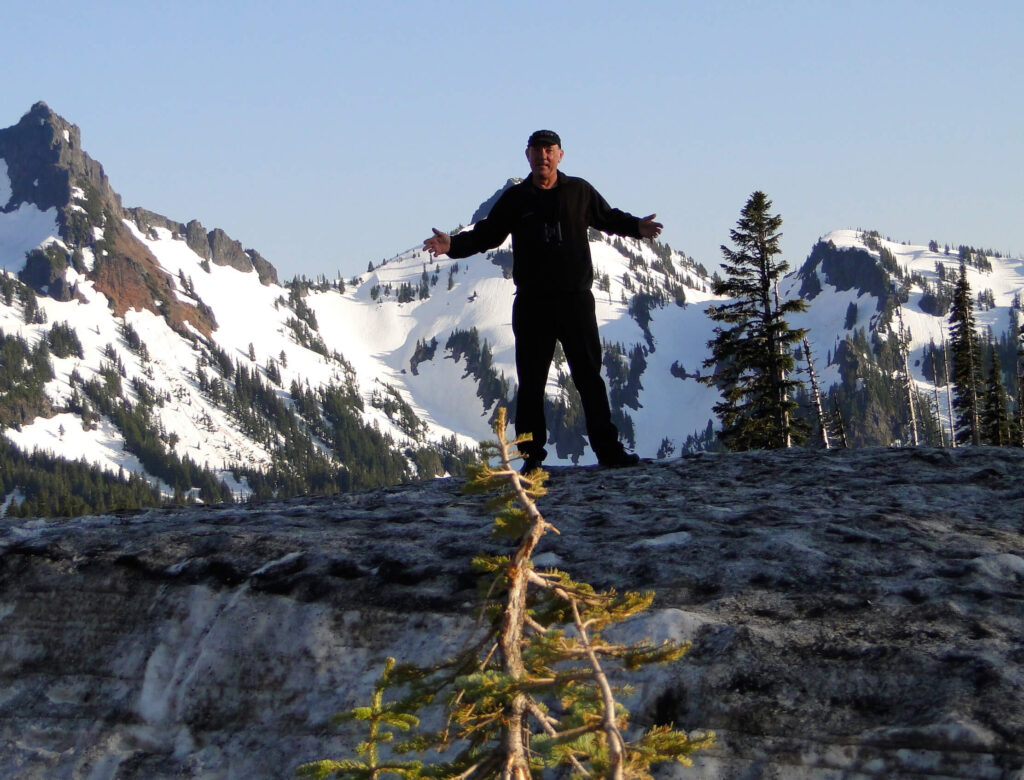
We headed out early the following morning, winding east and down through the rest of the park, then up again and across the White Pass, at 4,500 feet. We descended to the vast rolling grasslands of the Columbia River Valley, with irrigated farms looking well tended and prosperous.
Still navigating by my hand-drawn map, and occasionally asking locals for directions, we found our way to a nice piece of gravel road, in the open sagelands now, then a final stretch of two-lane blacktop, and a few miles of Interstate 90. Our destination was an outdoor amphitheater on the banks of the Columbia called The Gorge—for the final show of the Time Machine tour.

Photo by Brian Catterson
Added to the forty-four shows and more than 23,000 miles of motorcycling from summer 2010, my bandmates and I had now performed a total of eighty-one shows, before almost one million people. With riding partners Michael and Brutus, I had ridden 36,729 motorcycle miles, covering North America, South America, and Europe.
Michael and I were glad to get in early that day to The Gorge, needing to pack up and move off the bus, while Dave (with welcome help from Brian) organized the trailer and loaded my California bike on a pallet, to ride in one of the equipment trucks back to Los Angeles.
I have written before that one of the things I like about playing outdoors is that I have a better view of the audience—especially in a location like The Gorge, where the crystalline twilight lingered into the beginning of the second set.
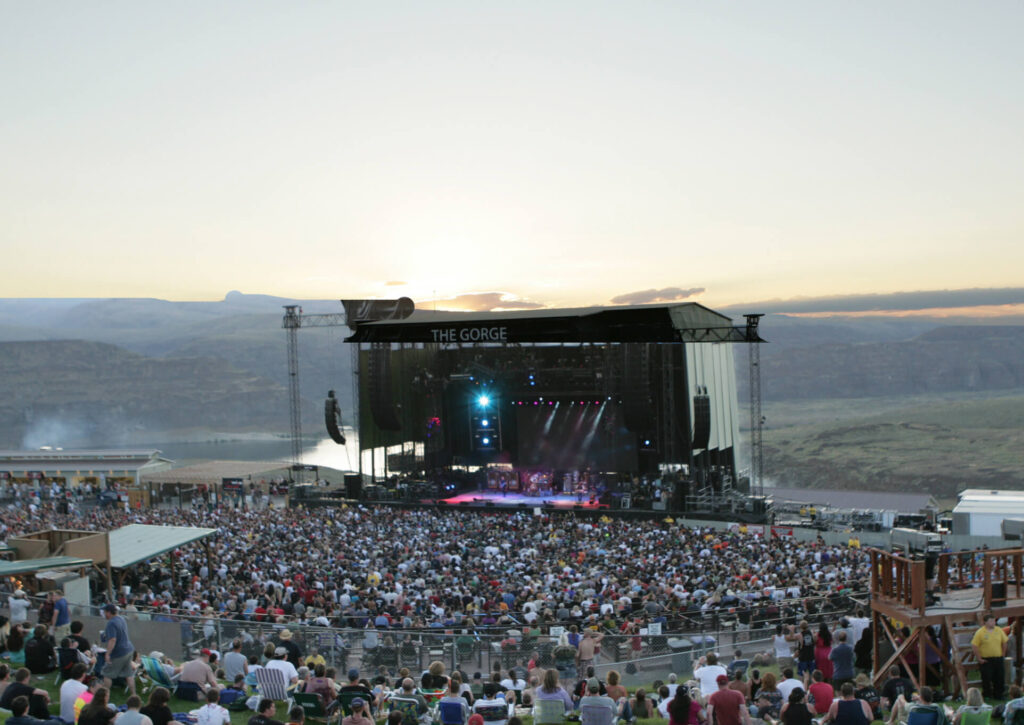
Just this year, the band instituted a new policy where we don’t start a show until at least ninety per cent of the ticket-buyers are in the venue. We knew that in the past some people missed the beginning of the show through no fault of their own—gridlock traffic, crowded entryways—and we didn’t think that was fair. With computerized ticket-takers these days, the arrivals are easy to calculate, and most nights, a half-hour or so before the scheduled show-time, the announcement came over the crew’s radios: “Ten minute hold.” Then sometimes a later one, “Add another five.” We never held longer than fifteen minutes—considering all of the people who had made it to the venue on time, not wanting to make them wait, plus there were union and building curfews to consider.
Some nights the Powers-That-Be—production manager C.B. and tour manager Liam—would even cut five minutes from the intermission, and we didn’t like that. As in one variation of Geddy’s announcement at the end of the first set, “We have to take a break . . . because we’re about a hundred! Don’t go away!”

Even people who don’t like our band have to appreciate our audiences. They simply enjoy themselves so much that it’s contagious! Some sing along with every word; some play air drums or guitar; most just smile and rock along with us. It’s a wonderful thing to witness, especially from my vantage point.
Not that it makes my job any easier—quite the opposite. I feel I have to live up to that level of devotion, so I drive myself all the harder. The touring stories I write during the breaks tend to have much more to say about the journeys than the shows, because the basic “story” of the show is pretty much the same: soundcheck at 5:00, warmup thirty minutes before showtime, then go up there and try my best to reach my inner standard of “acceptable” (never higher than “good”)—and either succeed or don’t. That’s the only variation to what is essentially the same story, eighty-one times.
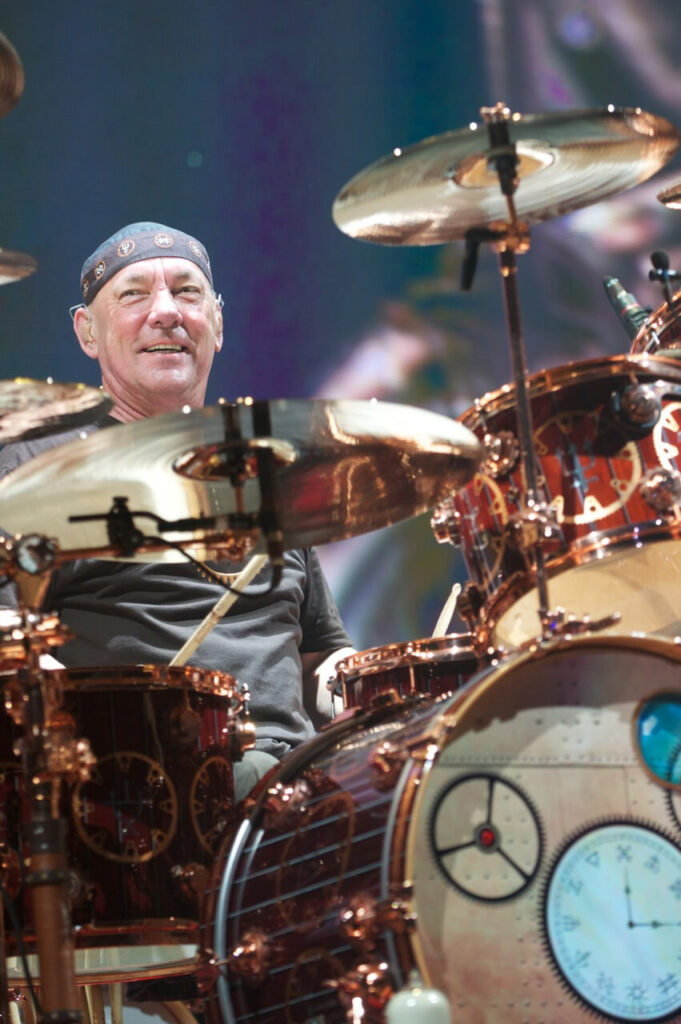
A smiling moment like this is rare for me onstage, and is usually directed at Alex’s antics, or crew members Anson and Doug’s appearances in the gorilla and chicken costumes (had to be there). Mostly, I know, I manifest the “grim determination” it takes for me to do that job.
But it is true that when I am on a concert tour, if I’m not happy on the drums, then I’m not happy anywhere. That is a deep observation. And it also helps to illustrate why a guy like Lorne (Gump) Wheaton is so important to me. Every day, without fail or flaw, Gump sets up, tunes, and maintains those drums just perfectly. He is able to feel how each part of the complicated drumset should relate to the player, so my workspace is always comfortable. Nothing naggingly a little out of whack.
When there is an equipment failure during the show—a broken tom head, loose snare mount—we choreograph the change almost automatically. I pick the break between songs when it’s possible, step down off the riser and out of the way, while Gump and Anson from the sound crew make the trade. Usually nobody else will even know anything happened.
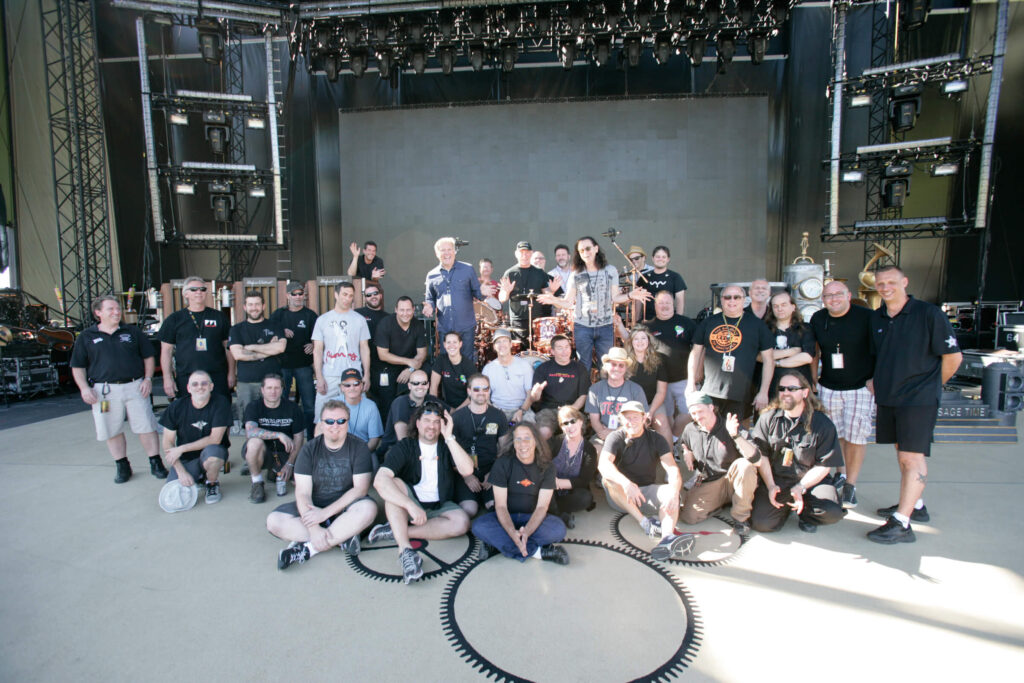
photo by Andrew MacNaughtan
These are some of the almost fifty people who deliver the show and put it all together every day. Drivers, riggers, band crew, lighting crew, sound crew, video and effects, security, nutrition—all that and so much more.
I try to show my special appreciation, daily and “annually,” to “my guys” on the crew, like Gump, who look after my personal world so well. Road manager Donovan seems to have a limitless, nearly miraculous stock of every specific traveling need I might have—whether it’s Macallan, Mitchum, or a Montblanc refill. Bus driver Dave goes way beyond that job description in taking care of bus housekeeping, motorcycle parts, supplies, and tools, service appointments, even restoring my fifteen-year-old motorcycle trailer on his own time last year.
Something Dave said to me at the end of one tour I will never forget: “You’re the only artist I’ve ever driven that I feel I work with instead of for.”
That meant a lot to me, and it’s the way I want things to be.
Like a remark I once made to Michael, in response to some profane and insulting tirade, “I love that you feel you can talk to me that way—but I really wish you wouldn’t.”
He likes to quote that to others, and thinks it’s hilarious—in light of him enduring my abuse and slanderous banter while I drag him through frying pans and freezers. Or Brutus, following me through Brazilian rainforests and along Welsh cowpaths—designing adventurous routes and fantastic destinations, just so he can follow me around to them.
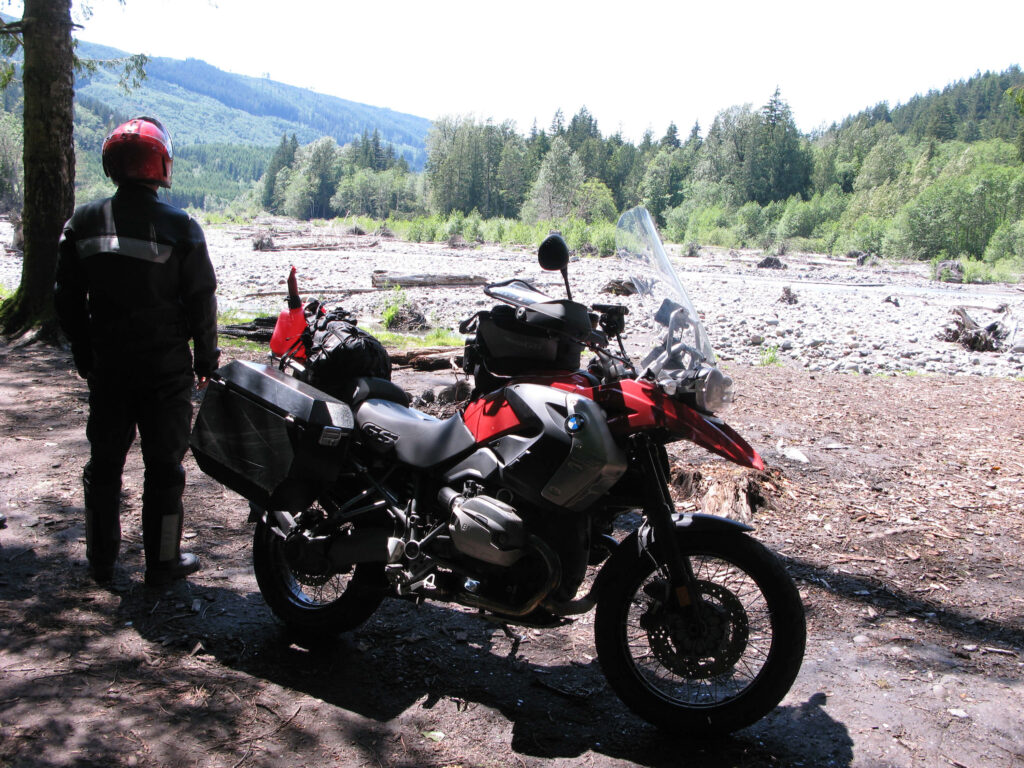
Photo by Brian Catterson
Thousands of people stand in front of the three of us when we’re onstage—but a lot of important people stand behind us, too, a network that’s almost immeasurable. And . . . let’s not forget the ones who stand behind us at home.
That can be the loneliest and least-appreciated place of all—at least by outsiders. After I was home for a day off after the Phoenix show, then had to leave the next afternoon for a show in San Diego, little Olivia, almost two now, woke up from her nap and went running down the hall toward my office, saying, “Go see Daddy!” When she was told, “Daddy’s gone to work again,” she burst into tears. Hearing about that made me feel very bad. As I’ve written before, I can stand missing her, but I can’t stand her missing me.
However, on the “happy side” of that equation, an audience of more than 13,000 people attended the final show of our Time Machine Tour, on July 2, 2011. Most of them had traveled a considerable distance—The Gorge is a long way from anywhere (the nearest town, humorously, is George, Washington). But we too had traveled a long way to get to that stage. And despite how many shows we had played, our weariness, and our sheer age, we managed to pull off a magic show that night.
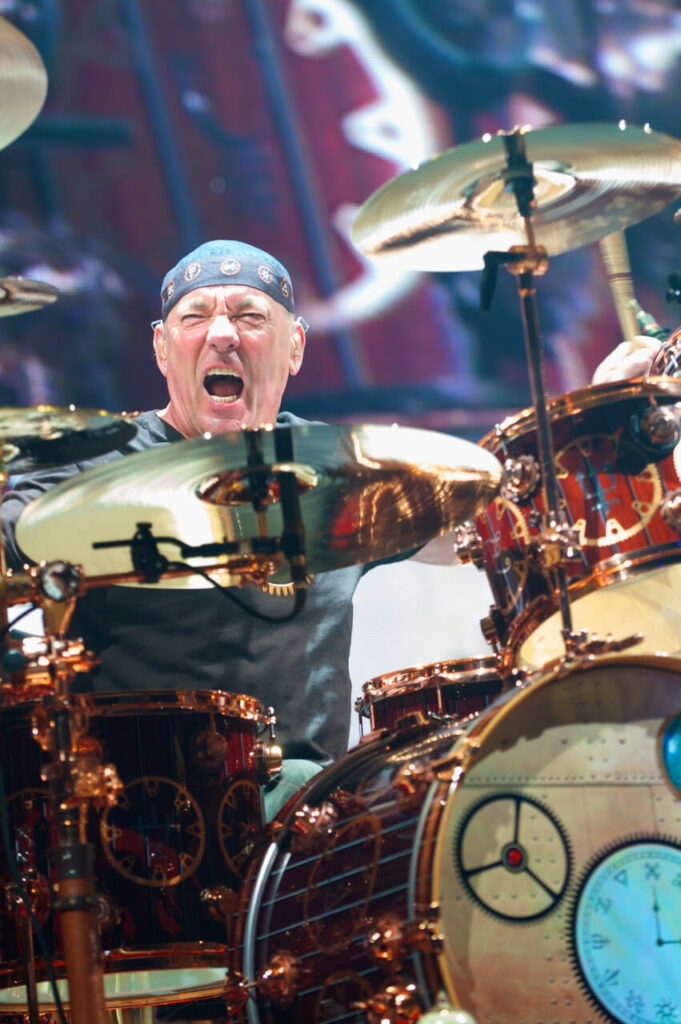
Photo by John Arrowsmith
We could feel it in our ensemble playing, tight and energetic, but these days an exceptional night is often apparent in our improvised sections—Geddy on his bass in the outro of “Leave That Thing Alone,” Alex in the frenetic solo section of “Working Man,” and for me, the first half of my solo. When the three of us are at the top of our individual games, we are able to elevate the whole to a sublime synergy.
At the end of the show, as we bowed and waved and Geddy thanked the audience for being so great, at that show and so many others, I heard him drop the f-bomb—for the first time in history. After saying, “It has been great,” he repeated that phrase and added that emphatic modifier. It was definitely a case of “when no other word would do”—to express how successful the tour had been, how much it meant to us, and how much we appreciated the people who had made it great.
In that moment, the three of us knew that at last we would be stepping away from the “frying pan” of live performance (the crucible) for a while, and would have some time off to chill: “the freezer.”
And what a great way to mark that transition.
Sometimes things are so perfectly right that you can’t help but get carried away in the moment . . .
